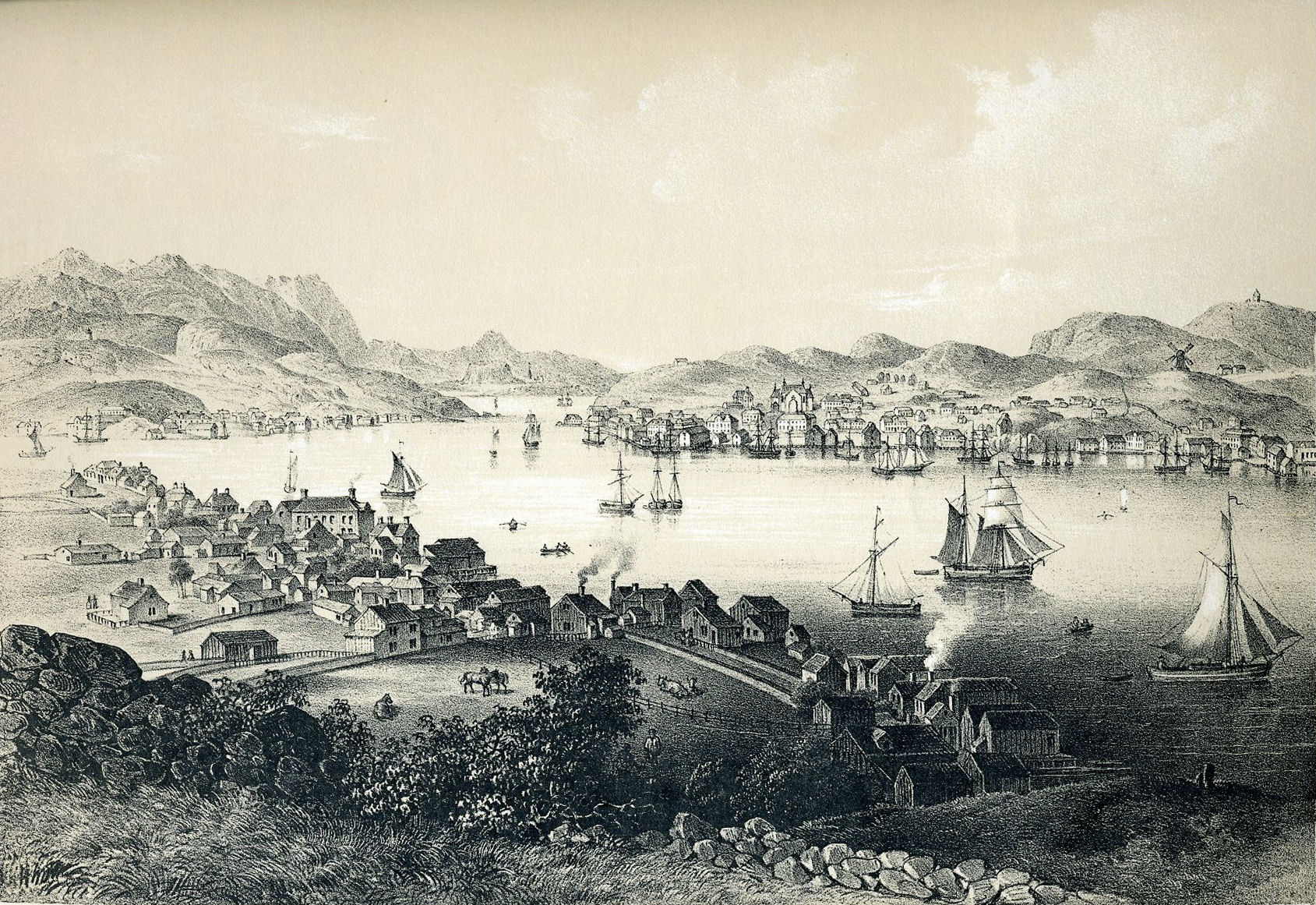|
Atlanterhavsvegen
The Atlantic Ocean Road or the Atlantic Road ( no, Atlanterhavsvegen / Atlanterhavsveien) is an long section of County Road 64 that runs through an archipelago in Hustadvika and Averøy municipalities in Møre og Romsdal county, Norway. It passes by Hustadvika, an unsheltered part of the Norwegian Sea, connecting the island of Averøy with the mainland and Romsdalshalvøya peninsula. It runs between the villages of Kårvåg in Averøy and Vevang in Hustadvika. It is built on several small islands and skerries, which are connected by several causeways, viaducts and eight bridges—the most prominent being Storseisundet Bridge. The route was originally proposed as a railway line in the early 20th century, but this was abandoned. Serious planning of the road started in the 1970s, and construction started on August 1st 1983. During construction the area was hit by 12 European windstorms. The road was opened on 7 July 1989, having cost 122 million Norwegian krone (NOK), of which 25 ... [...More Info...] [...Related Items...] OR: [Wikipedia] [Google] [Baidu] |
Kristiansund
Kristiansund (, ; historically spelled Christianssund and earlier named Fosna) is a municipality on the western coast of Norway in the Nordmøre district of Møre og Romsdal county. The administrative center of the municipality is the town of Kristiansund (established in 1742), which is the major town for the whole Nordmøre region. Other notable settlements in the municipality include the villages of Kvalvåg, Rensvik, and Nedre Frei. The municipality is the 333rd largest by area out of the 356 municipalities in Norway. Kristiansund is the 52nd most populous municipality in Norway with a population of 24,013. The municipality's population density is and its population has increased by 0.8% over the previous 10-year period. General information The parish of ''Christianssund'' was established as a municipality on 1 January 1838 (see formannskapsdistrikt law). Initially, the small island municipality included just the town of Christianssund and its immediate surroundi ... [...More Info...] [...Related Items...] OR: [Wikipedia] [Google] [Baidu] |
Norwegian County Road 64
County Road 64 ( no, Fylkesvei 64) is a two-lane highway which runs between the towns of Kristiansund and Åndalsnes in Møre og Romsdal county, Norway. It branches from National Road 70 in Kristiansund, runs through the Atlantic Ocean Tunnel, across the island of Averøya, and across the Atlantic Ocean Road to Eide Municipality. It continues to Årø in Molde Municipality via the Tussen Tunnel, then heads under Fannefjorden in the Fannefjord Tunnel, across the island of Bolsøya then over the Bolsøy Bridge to the Skåla Peninsula. It then crosses Langfjorden on the Åfarnes– Sølsnes Ferry, and enters Rauma Municipality. It intersects with the European route E136 highway in the town of Åndalsnes. The Atlantic Ocean Road was in 2006 described as "the world's best road trip" by ''The Guardian ''The Guardian'' is a British daily newspaper A newspaper is a periodical publication containing written information about current events and is often typed in ... [...More Info...] [...Related Items...] OR: [Wikipedia] [Google] [Baidu] |
Storseisundet Bridge
The Storseisundet Bridge ( no, Storseisundbrua) is the longest of the eight bridges that make up the Atlanterhavsveien ("The Atlantic Road"), the road connection from the mainland Romsdal peninsula to the island of Averøya in Møre og Romsdal county, Norway. The bridge sits on the border between Hustadvika Municipality and Averøy Municipality and passes through an archipelago as it links mainland Norway with the island of Averoy. It is one of the country's official national tourist routes. Storseisundet Bridge is a cantilever bridge that is long and with a maximum clearance to the sea of . It was opened on 7 July 1989, and it was a toll road until June 1999. Over the six years that it took to construct, workers struggled with the region's wild weather and were interrupted by twelve hurricanes. One hundred and twenty-two million Norwegian krone were spent completing the project, seventy-five percent of which came from public grants. The rest of the funding was recovered with ... [...More Info...] [...Related Items...] OR: [Wikipedia] [Google] [Baidu] |
Norwegian Public Roads Administration
The Norwegian Public Roads Administration ( no, Statens vegvesen) is a Norwegian government agency responsible for national and county public roads in Norway. This includes planning, construction and operation of the national and county road networks, driver training and licensing, vehicle inspection, and subsidies to car ferries. The agency is led by the Directorate of Public Roads (Vegdirektoratet), and is subordinate to the Ministry of Transport and Communications. The Norwegian Public Roads Administration is divided into five regions and thirty districts, which are subordinate to the directorate. The directorate is based in Oslo. The Norwegian Public Roads Administration is one of the largest government agencies of Norway in terms of budget. In matters concerning national roads, the agency is subordinate to the ministry and in matters concerning county roads subordinate to the county administration. Core activities The Norwegian Public Roads Administration strives to ensure ... [...More Info...] [...Related Items...] OR: [Wikipedia] [Google] [Baidu] |
Norwegian Krone
The krone (, abbreviation: kr (also NKr for distinction); code: NOK), plural ''kroner'', is currency of the Kingdom of Norway (including Svalbard). Traditionally known as the Norwegian crown in English. It is nominally subdivided into 100 '' øre'', although the last coins denominated in øre were withdrawn in 2012. The krone was the thirteenth-most-traded currency in the world by value in April 2010, down three positions from 2007. The Norwegian krone is also informally accepted in many shops in Sweden and Finland that are close to the Norwegian border, and also in some shops in the Danish ferry ports of Hirtshals and Frederikshavn. Norwegians spent 14.1 billion NOK on border shopping in 2015 compared to 10.5 billion NOK spent in 2010. Border shopping is a fairly common practice amongst Norwegians, though it is seldom done on impulse. Money is spent mainly on food articles, alcohol, and tobacco, in that order, usually in bulk or large quantities. This is due to consid ... [...More Info...] [...Related Items...] OR: [Wikipedia] [Google] [Baidu] |
Toll Road
A toll road, also known as a turnpike or tollway, is a public or private road (almost always a controlled-access highway in the present day) for which a fee (or '' toll'') is assessed for passage. It is a form of road pricing typically implemented to help recoup the costs of road construction and maintenance. Toll roads have existed in some form since antiquity, with tolls levied on passing travelers on foot, wagon, or horseback; a practice that continued with the automobile, and many modern tollways charge fees for motor vehicles exclusively. The amount of the toll usually varies by vehicle type, weight, or number of axles, with freight trucks often charged higher rates than cars. Tolls are often collected at toll plazas, toll booths, toll houses, toll stations, toll bars, toll barriers, or toll gates. Some toll collection points are automatic, and the user deposits money in a machine which opens the gate once the correct toll has been paid. To cut costs and minimise ti ... [...More Info...] [...Related Items...] OR: [Wikipedia] [Google] [Baidu] |
Cultural Heritage
Cultural heritage is the heritage of tangible and intangible heritage assets of a group or society that is inherited from past generations. Not all heritages of past generations are "heritage"; rather, heritage is a product of selection by society. Cultural heritage includes cultural property, tangible culture (such as buildings, monuments, landscapes, books, works of art, and artifacts), intangible heritage, intangible culture (such as folklore, traditions, language, and knowledge), and natural heritage (including culturally significant landscapes, and biodiversity).Ann Marie Sullivan, Cultural Heritage & New Media: A Future for the Past, 15 J. MARSHALL REV. INTELL. PROP. L. 604 (2016) https://repository.jmls.edu/cgi/viewcontent.cgi?article=1392&context=ripl The term is often used in connection with issues relating to the protection of Indigenous intellectual property. The deliberate act of keeping cultural heritage from the present for the future is known as Conservation (cul ... [...More Info...] [...Related Items...] OR: [Wikipedia] [Google] [Baidu] |
National Tourist Routes In Norway
National Tourist Routes ( no, Nasjonale turistveger) are eighteen highways in Norway designated by the Norwegian Public Roads Administration for their picturesque scenery and tourist-friendly infrastructure, such as rest stops and viewpoints. The routes cover and are located along the West Coast, in Northern Norway and in the mountains of Southern Norway. The authorities have coordinated the establishment of accommodation, cultural activities, dining, sale of local arts and crafts, and natural experiences along the tourist roads. The overall goal of the project is to increase tourism in the rural areas through which the roads run. The project started in 1994 and was initially limited to Sognefjellsvegen, Gamle Strynefjellsveg, Hardanger and the Helgeland Coast Route. These were officially designated National Tourist Routes in 1997, and, the following year, the Storting decided to expand the project. Municipalities were asked to nominate roads, resulting in 52 nominees c ... [...More Info...] [...Related Items...] OR: [Wikipedia] [Google] [Baidu] |
Atlantic Ocean Tunnel
The Atlantic Ocean Tunnel ( no, links=no, Atlanterhavstunnelen) is an undersea tunnel that is part of Norwegian County Road 64 which connects Kristiansund Municipality to Averøy Municipality in Møre og Romsdal county, Norway. The eastern end of the tunnel is on Kirkelandet island in the town of Kristiansund and the western end of the tunnel is on the island of Averøya, just west of the village of Sveggen. The long tunnel runs beneath the Bremsnesfjorden, reaching a depth of , making it one of the deepest undersea tunnels in the world. Construction began in 2006, and the tunnel opened on 19 December 2009, later than initially estimated. Breakthrough was in March 2009. Problems with water leaks caused delays and cost overruns. The name of the tunnel comes from its connection of two islands located at the open Atlantic Ocean, and serves as an extension of (Atlantic Ocean road), a popular tourist attraction. road runs over a series of small islands with views of sea, fjord, ... [...More Info...] [...Related Items...] OR: [Wikipedia] [Google] [Baidu] |





